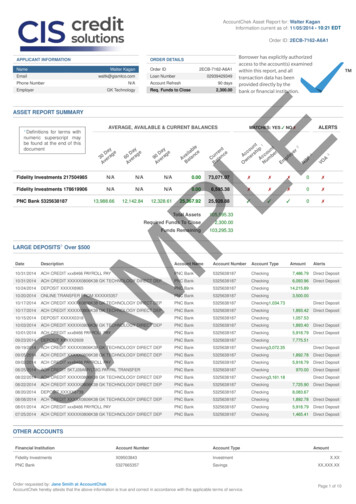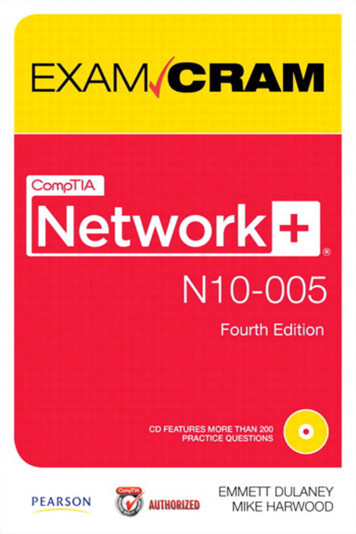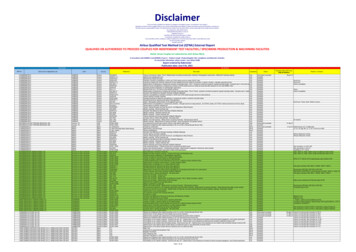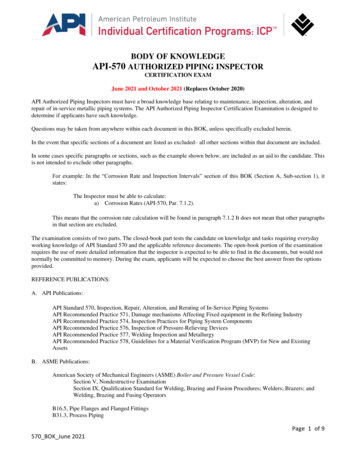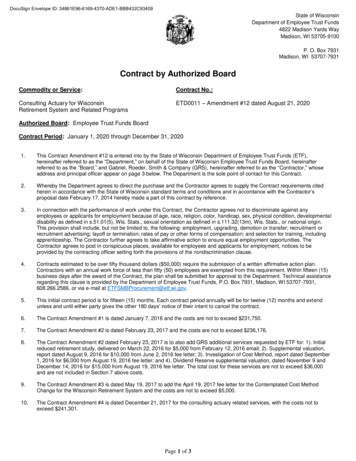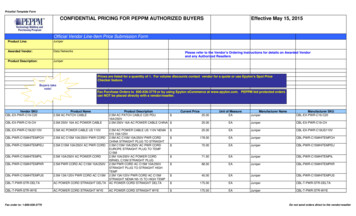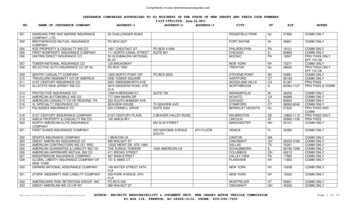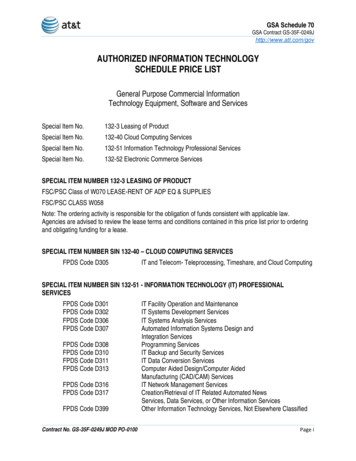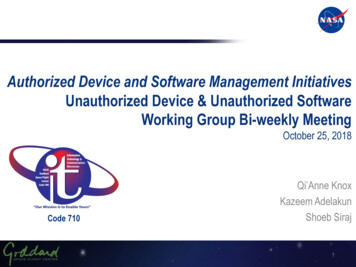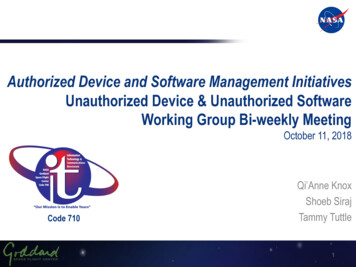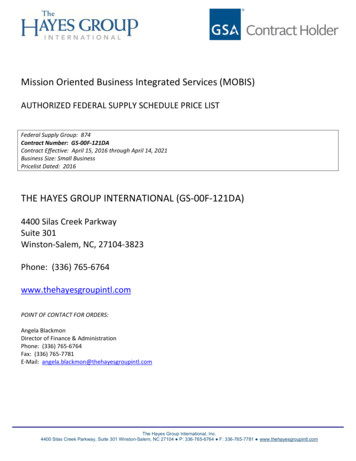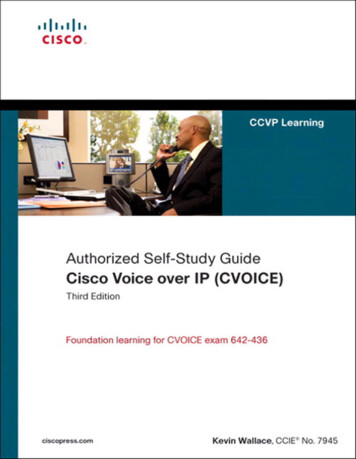
Transcription
iiAuthorized Self-Study Guide: Cisco Voice over IP (CVOICE)Authorized Self-Study GuideCisco Voice over IP (CVOICE),Third EditionKevin WallaceCopyright 2009 Cisco Systems, Inc.Published by:Cisco Press800 East 96th StreetIndianapolis, IN 46240 USAAll rights reserved. No part of this book may be reproduced or transmitted in any form or by any means,electronic or mechanical, including photocopying, recording, or by any information storage and retrievalsystem, without written permission from the publisher, except for the inclusion of brief quotations in areview.Printed in the United States of AmericaFirst Printing July 2008Library of Congress Cataloging-in-Publication Data:Wallace, Kevin, CCNP.Authorized self-study guide : Cisco Voice over IP (CVoice) / Kevin Wallace. — 3rd ed.p. cm.ISBN 978-1-58705-554-6 (hbk. : CD-ROM) 1. Internet telephony—Examinations—Study guides. 2.Electronic data processing personnel—Certification—Study guides. I. Title. II. Title: Cisco Voice over IP(CVoice).TK5105.8865.W3345 2008004.69’5—dc222008022672ISBN-13: 978-1-58705-554-6ISBN-10: 1-58705-554-6Warning and DisclaimerThis book is designed to provide information about the Cisco Voice over IP (CVOICE) certificationtopics. Every effort has been made to make this book as complete and as accurate as possible, but nowarranty or fitness is implied.The information is provided on an “as is” basis. The authors, Cisco Press, and Cisco Systems, Inc., shallhave neither liability nor responsibility to any person or entity with respect to any loss or damages arisingfrom the information contained in this book or from the use of the discs or programs that mayaccompany it.The opinions expressed in this book belong to the author and are not necessarily those of CiscoSystems, Inc.
xviiiAuthorized Self-Study Guide: Cisco Voice over IP (CVOICE)ForewordCisco certification Self-Study Guides are excellent self-study resources for networking professionals to maintain and increase internetworking skills and to prepare for Cisco CareerCertification exams. Cisco Career Certifications are recognized worldwide and providevaluable, measurable rewards to networking professionals and their employers.Cisco Press exam certification guides and preparation materials offer exceptional—andflexible—access to the knowledge and information required to stay current in one’s field ofexpertise or to gain new skills. Whether used to increase internetworking skills or as a supplement to a formal certification preparation course, these materials offer networking professionals the information and knowledge required to perform on-the-job tasks proficiently.Developed in conjunction with the Cisco certifications and training team, Cisco Pressbooks are the only self-study books authorized by Cisco, and they offer students a series ofexam practice tools and resource materials to help ensure that learners fully grasp the concepts and information presented.Additional authorized Cisco instructor-led courses, e-learning, labs, and simulations areavailable exclusively from Cisco Learning Solutions Partners worldwide. To learn more,visit http://www.cisco.com/go/training.I hope you will find this guide to be an essential part of your exam preparation and professional development, as well as a valuable addition to your personal library.Drew RosenManager, Learning & DevelopmentLearning@CiscoJune 2008
xixIntroductionWith the rapid adoption of Voice over IP (VoIP), many telephony and data network technicians, engineers, and designers are now working to become proficient in VoIP. Professionalcertifications, such as the Cisco Certified Voice Professional (CCVP) certification, offervalidation of an employee’s or a consultant’s competency in specific technical areas.This book mirrors the level of detail found in the Cisco CVOICE Version 6.0 course, whichmany CCVP candidates select as their first course in the CCVP track. Version 6.0 represents a significant update over Version 5.0 of the CVOICE course, because Version 6.0integrates much of the content previously found in the more advanced Implementing CiscoVoice Gateways and Gatekeepers (GWGK) course.A fundamental understanding of traditional telephony, however, would certainly benefit aCVOICE student or a reader of this book. If you think you lack a fundamental understanding of traditional telephony, a recommended companion for this book is the Cisco PressVoice over IP First-Step book (ISBN: 978-1-58720-156-1), which is also written by thisbook’s author. Voice over IP First-Step is written in a conversational tone and teaches concepts surrounding traditional telephony and how those concepts translate into a VoIP environment.Additional Study ResourcesThis book contains a CD with approximately 90 minutes of video, where you will see theauthor demonstrate a variety of basic VoIP configurations. The videos were originallydeveloped for NetMaster Class (http://www.netmasterclass.com), a company specializingin CCIE Lab training. These video-on-demand titles are as follows:Analog Voice Port ConfigurationDigital Voice Port ConfigurationDial Peer ConfigurationH.323 ConfigurationMGCP ConfigurationSIP ConfigurationAs an additional reference for readers pursuing the CCVP certification, the author has created a website with recommended study resources (some free and some recommended forpurchase) for all courses in the CCVP track. These recommendations can be found at thefollowing URL: http://www.voipcertprep.com.
xxAuthorized Self-Study Guide: Cisco Voice over IP (CVOICE)Goals and MethodsThe primary objective of this book is to help the reader pass the 642-436 CVOICE exam,which is a required exam for the CCVP certification and for the Cisco Rich MediaCommunications Specialist specialization.One key methodology used in this book is to help you discover the exam topics that youneed to review in more depth, to help you fully understand and remember those details,and to help you prove to yourself that you have retained your knowledge of those topics.This book does not try to help you pass by memorization, but helps you truly learn andunderstand the topics by using the following methods: Helping you discover which test topics you have not mastered Providing explanations and information to fill in your knowledge gaps, includingdetailed illustrations and topologies as well as sample configurations Providing exam practice questions to confirm your understanding of core conceptsWho Should Read This Book?This book is primarily targeted toward candidates of the CVOICE exam. However, becauseCVOICE is one of the Cisco foundational VoIP courses, this book also serves as a VoIPprimer to noncertification readers.Many Cisco resellers actively encourage their employees to attain Cisco certifications andseek new employees already possessing Cisco certifications, for deeper discounts whenpurchasing Cisco products. Additionally, having attained a certification communicates toyour employer or customer that you are serious about your craft and have not simply“hung out a shingle” declaring yourself knowledgeable about VoIP. Rather, you haveproven your competency through a rigorous series of exams.How This Book Is OrganizedAlthough the chapters in this book could be read sequentially, the organization allows youto focus your reading on specific topics of interest. For example, if you already possess astrong VoIP background, you could skim the first two chapters (which cover foundationalVoIP topics, including an introduction to VoIP and elements of a VoIP network) and focuson the remaining seven chapters, which address more advanced VoIP concepts.Specifically, the chapters in this book cover the following topics:Chapter 1, “Introducing Voice over IP Networks”: This chapter describes VoIP, components of a VoIP network, the protocols used, and service considerations of integrating VoIP
xxiinto an existing data network. Also, this chapter considers various types of voice gatewaysand how to use gateways in different IP telephony environments.Chapter 2, “Considering VoIP Design Elements”: This chapter describes the challengesof integrating a voice and data network and explains solutions for avoiding problems whendesigning a VoIP network for optimal voice quality. Also, you learn the characteristics ofvoice codecs and digital signal processors and how to perform bandwidth calculations forVoIP calls.Chapter 3, “Routing Calls over Analog Voice Ports”: This chapter describes the variouscall types in a VoIP network. You then learn how to configure analog voice interfaces asnew devices are introduced into the voice path. Finally, you discover how to configure dialpeers, in order to add call routing intelligence to a router.Chapter 4, “Performing Call Signaling over Digital Voice Ports”: This chapterdescribes various digital interfaces and how to configure them. Also, you are introduced toQ Signaling (QSIG) and learn how to enable QSIG support.Chapter 5, “Examining VoIP Gateways and Gateway Control Protocols”: This chapterdetails the H.323, MGCP, and SIP protocol stacks, and you learn how to implement eachof these protocols on Cisco IOS gateways.Chapter 6, “Identifying Dial Plan Characteristics”: This chapter describes the components and requirements of a dial plan and discusses how to implement a numbering planusing Cisco IOS gateways.Chapter 7, “Configuring Advanced Dial Plans”: This chapter shows you how to configure various digit manipulation strategies using Cisco IOS gateways. Additionally, you learnhow to influence path selection. This chapter then concludes with a discussion of the Classof Restriction (COR) feature, and you learn how to implement COR on Cisco IOS gateways to specify calling privileges.Chapter 8, “Configuring H.323 Gatekeepers”: This chapter describes the function of aCisco IOS gatekeeper. Also, you learn how to configure a gatekeeper for functions such asregistration, address resolution, call routing, and call admission control (CAC).Chapter 9, “Establishing a Connection with an Internet Telephony Service Provider”:This chapter describes Cisco Unified Border Element (Cisco UBE) functions and features.You learn how a Cisco UBE is used in current enterprise environments and how to implement a Cisco UBE router to provide protocol interworking.
After reading this chapter, you should be able to performthe following tasks: Describe the various call types in a VoIP network. Configure analog voice interfaces as new devices areintroduced into the voice path. Configure dial peers so you can add call routingintelligence to a router.
CHAPTER 3Routing Calls over Analog VoicePortsVoice gateways bridge the gap between the VoIP world and the traditional telephony world(for example, a private branch exchange [PBX], the public switched telephone network{PSTN], or an analog phone). Cisco voice gateways connect to traditional telephony devicesvia voice ports. This chapter introduces basic configuration of analog and digital voice portsand demonstrates how to fine-tune voice ports with port-specific configurations. Uponcompleting this chapter, you will be able to configure voice interfaces on Cisco voiceenabled equipment for connection to traditional, nonpacketized telephony equipment.Introducing Analog Voice Applications on Cisco IOSRoutersBefore delving into the specific syntax of configuring voice ports, this section considersseveral examples of voice applications. The applications discussed help illustrate thefunction of the voice ports, whose configuration is addressed in the next section.Different types of applications require specific types of ports. In many instances, thetype of port is dependent on the voice device connected to the network. Different typesof voice applications include the following: Local calls On-net calls Off-net calls Private line, automatic ringdown (PLAR) calls PBX-to-PBX calls Intercluster trunk calls On-net to off-net callsThe following sections discuss each in detail and provide an example.Local CallsLocal calls, as illustrated in Figure 3-1, occur between two telephones connected to oneCisco voice-enabled router. This type of call is handled entirely by the router and doesnot travel over an external network. Both telephones are directly connected to ForeignExchange Station (FXS) ports on the router.
126Authorized Self-Study Guide: Cisco Voice over IP (CVOICE)555-0188PBXDial:“555-0188”IP WANVGatewayFigure 3-1Ring!!VGatewayLocal CallsAn example of a local call is one staff member calling another staff member at the sameoffice. This call is switched between two ports on the same voice-enabled router.On-Net CallsOn-net calls occur between two telephones on the same data network, as shown inFigure 3-2. The calls can be routed through one or more Cisco voice-enabled routers, butthe calls remain on the same data network. The edge telephones attach to the networkthrough FXS ports or through a PBX, which typically connects to the network via a T1connection. IP phones that connect to the network via switches place on-net callsthrough Cisco Unified Communications Manager. The connection across the data network can be a LAN connection, as in a campus environment, or a WAN connection, as inan enterprise ng!!VGatewayIP WANAustinToll-BypassPSTNFigure 3-2On-Net CallsVGatewaySan Jose
Chapter 3: Routing Calls over Analog Voice PortsNote The act of routing voice data across the WAN instead of the PSTN is known astoll-bypass. Originally, companies saved significant amounts of money using this strategy,which was one of the first major business benefits of a VoIP-enabled network.An example of an on-net call is one staff member calling another staff member at a remoteoffice. The call is sent from the local voice-enabled router, across the IP network, and terminated on the remote office voice-enabled router.Off-Net CallsFigure 3-3 shows an example of an off-net call. To gain access to the PSTN, the user dialsan access code, such as 9, from a telephone directly connected to a Cisco voice-enabledrouter or PBX. The connection to the PSTN is typically a single analog connection via aForeign Exchange Office (FXO) port or a digital T1 or E1 connection.Dial AccessCode: “9”Ring!!PSTNFigure 3-3VGatewayOff-Net CallsAn example of an off-net call is a staff member calling a client who is located in the samecity. The call is sent from the local voice-enabled router that is acting as a gateway to thePSTN. The call is then sent to the PSTN for call termination.PLAR CallsPLAR calls automatically connect a telephone to a second telephone when the first telephone goes off hook, as depicted in Figure 3-4. When this connection occurs, the userdoes not get a dial tone, because the voice-enabled port that the telephone is connectedto is preconfigured with a specific number to dial. A PLAR connection can workbetween any type of signaling, including E&M, FXO, FXS, or any combination of analog and digital interfaces. For example, you might have encountered a PLAR connectionat an airline ticket counter where you pick up a handset and are immediately connectedwith an airline representative.127
128Authorized Self-Study Guide: Cisco Voice over IP (CVOICE)Ring!!PBXConfiguredto Dial:“555-0199”555-0199VGatewayFigure 3-4IP WANVGatewayPLAR CallsAn example of a PLAR call is a client picking up a customer service telephone located inthe lobby of the office and being automatically connected to a customer service representative without dialing any digits. The call is automatically dialed based on the PLARconfiguration of the voice port. In this case, as soon as the handset goes off hook, thevoice-enabled router generates the preconfigured digits to place the call.PBX-to-PBX CallsPBX-to-PBX calls, as shown in Figure 3-5, originate at a PBX at one site and terminate ata PBX at another site while using the network as the transport between the two locations.Many business environments connect sites with private tie trunks. When migrating to aconverged voice and data network, this same tie-trunk connection can be emulated acrossan IP network. Modern PBX connections to a network are typically digital T1 or E1 withchannel associated signaling (CAS) or Primary Rate Interface (PRI) signaling, althoughPBX connections can also be analog.NotePBX-to-PBX calls are another form of toll-bypass.An example of a PBX-to-PBX call is one staff member calling another staff member at aremote office. The call is sent from the local PBX, through a voice-enabled router, acrossthe IP network, through the remote voice-enabled router, and terminated on the remoteoffice PBX.
Chapter 3: Routing Calls over Analog Voice Ports555-0150Ring!!PBX “A”PBX “B”555-0111IP WANVGatewayVGatewayToll-BypassPSTNFigure 3-5PBX-to-PBX CallsIntercluster Trunk CallsAs part of an overall migration strategy, a business might replace PBXs with Cisco UnifiedCommunications Managers. This includes IP phones connected to the IP network. CiscoUnified Communications Manager performs the call-routing functions formerly providedby the PBX. When an IP phone call is placed using a configured Cisco UnifiedCommunications Manager, the call is assessed to see if the call is destined for another IPphone under its control or if the call must be routed to a remote Cisco Unified Communications Manager for call completion. Intercluster trunk calls, as depicted in Figure 3-6, arerouted between Cisco Unified Communications Manager clusters using a trunk.Cisco UnifiedCommunicationsManagerSite ACisco UnifiedCommunicationsManagerSite BIPIP WANSiFigure 3-6Intercluster Trunk CallsSi129
130Authorized Self-Study Guide: Cisco Voice over IP (CVOICE)An example of an intercluster trunk call is one staff member calling another staff memberat a remote office using an IP phone. The call setup is handled by the Cisco UnifiedCommunications Managers at each location. After the call is set up, the IP phones generate Real-time Transport Protocol (RTP) segments that carry voice data between sites.On-Net to Off-Net CallsWhen planning a resilient call-routing strategy, you might need to reroute calls through asecondary path should the primary path fail. An on-net to off-net call, as illustrated inFigure 3-7, originates on an internal network and is routed to an external network, usuallyto the PSTN. On-net to off-net call-switching functionality might be necessary when anetwork link is down or if a network becomes overloaded and unable to handle all callspresented.214WAN is downor congested!!IP WANVGatewayVGateway3PSTNFigure 3-7On-Net to Off-Net CallsNote On-net to off-net calls might occur as a result of dial plan configuration, or theymight be redirected by Call Admission Control (CAC).An example of an on-net to off-net call is one staff member calling another staff memberat a remote office while the WAN link is congested. When the originating voice-enabledrouter determines it cannot complete the call across the WAN link, it sends the call to thePSTN with the appropriate dialed digits to terminate the call at the remote office via thePSTN network.The following steps, numbered in Figure 3-7, summarize the call flow of an on-net to offnet call:
Chapter 3: Routing Calls over Analog Voice PortsStep 1.A user on the network initiates a call to a remote site.Step 2.The output of the WAN gateway is either down or congested, so the call isrerouted.Step 3.The call connects to the PSTN.Step 4.The PSTN completes the call to the remote site.Summarizing Examples of Voice Port ApplicationsTable 3-1 lists application examples for each type of call.Table 3-1Voice Port Call TypesType of CallExampleLocal callOne staff member calls another staff member at the same office. Thecall is switched between two ports on the same voice-enabled router.On-net callOne staff member calls another staff member at a remote office. Thecall is sent from the local voice-enabled router, across the IP network,and is terminated on the remote office voice-enab
Electronic data processing personnel—Certification—Study guides. I. Title. II. Title: Cisco Voice over IP (CVoice). TK5105.8865.W3345 2008 004.69’5—dc22 2008022672 ISBN-13: 978-1-58705-554-6 ISBN-10: 1-58705-554-6 Warning and Disclaimer This book is designed to provide information about the Ci
